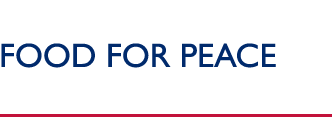 |
 |
|
 |
 |
 |
 Introduction Introduction
Home
- List of Acronyms
- List of Cooperating Sponsors
- Conversion Tables
Part One
Section I:
Commodities
- Commodity Availability
- Commodity Characteristics
- References
Section II:
Food Commodity
Fact Sheets
- Beans, Black
- Beans, Great Northern
- Beans, Kidney (Light Red, Dark Red, All types)
- Beans, Navy (Pea Beans)
- Beans, Pink
- Beans, Pinto
- Beans, Small Red
- Bulgur (BW)
- Bulgur, Soy Fortified (SFBW)
- Corn (bagged, bulk)
- Cornmeal
- Cornmeal, Soy-Fortified (CMSF)
- Corn Soy Blend (CSB)
- Corn Soy Milk (CSM)
- Corn Soy Milk, Instant (ICSM)
- Lentils
- Non Fat Dry Milk (NFDM)
- Peas
- Rice
- Rice (Parboiled)
- Sorghum
- Sorghum Grits, Soy-Fortified (SFSG)
- Fortified Refined Vegetable Oil
- Wheat
- Wheat Flour
- Wheat Soy Blend (WSB)
- Wheat Soy Milk (WSM)
Section III:
Storage/Shelflife
Specifications
- Storage Specifications
- Storage Inspection Checklist
- Shelf Life of Agricultural Commodities
- References
Section IV:
Controlling
Damage to Food
Commodities
- Cleaning and Inspecting
- Insect Control
- Rodent Control
- Reference Chart for Controlling Damage to Food Commodities
- References
 Part Two Part Two
 An Overview An Overview
 Part Three Part Three
|
|
 |
 |
|
Section II: Food Commodity Fact Sheets |
 |
Updated January 2006
Bulgur
This
processed commodity is
generally used as a staple food for all categories of programs. Bulgur
is cracked, debranned, and partially precooked to lower final cooking
time, reduce toughness and some of the crude fiber.
1.
Nutritional Values (per 100 g)
These are average values, taken from the U.S. Department of
Agriculture, Agricultural Research Service (USDA:ARS) 1998 USDA
Nutrient Database, Release 12, Laboratory Home Page (http://www.nal.usda.gov/fnic/foodcomp).
They are provided as a guideline and are appropriate for use in the
calculation of food aid rations. Please note: these values may or may
not meet the exact specifications of the USDA Export Announcements to
Purchase for the P.L. 480 Program. The values for thiamin, riboflavin,
niacin, vitamin A, calcium and iron represent the minimum levels of
enrichment nutrients (converted to a 100 g basis) as listed in
Specifications below.
| Nutrient
|
Amount
|
Unit
|
| Water |
9.0 |
g |
| Energy |
342.0 |
Kcal |
| Protein |
12.3 |
g |
| Total Lipid |
1.3 |
g |
| Carbohydrate |
75.9 |
g |
| Fiber,
total dietary |
18.3 |
g |
| Ash |
1.5 |
g |
| Calcium |
110 |
mg |
| Iron |
2.90 |
mg |
| Magnesium |
164 |
mg |
| Phosphorus |
300 |
mg |
| Potassium |
410 |
mg |
| Sodium |
17.0 |
mg |
| Zinc |
1.9 |
mg |
| Copper |
0.3 |
mg |
| Manganese |
3.0 |
mg |
| Selenium |
2 |
mcg |
| Vitamin C |
0 |
mg |
| Thiamin |
0.44 |
mg |
| Riboflavin |
0.26 |
mg |
| Niacin |
3.53 |
mg |
| Pantothenic acid |
1.0 |
mg |
| Vitamin B-6 |
0.3 |
mg |
| Folate |
150 |
mcg |
| Vitamin
B-12 |
0 |
mcg |
| Vitamin A |
2205 |
IU |
| Vitamin E |
0.2 |
mg-ATE |
| Vitamin D |
n/a |
IU |
| Iodine |
n/a |
mcg |
| Pyridoxine HCL |
n/a |
mg |
2.
Components: (per 100 g)
100% Whole Wheat
3.
Specifications:
The bulgur shall be milled from wheat of any of the classes defined in
the "Official Grain Standards of the United States," for wheat except
red durum wheat or mixtures of wheat of contrasting classes.
CHEMICAL
AND PHYSICAL REQUIREMENTS
| ITEM 1 |
Minimum |
Maximum |
| Moisture |
-- |
11.5 |
| Protein (Nx5.7), % 2 |
9.3 |
-- |
| Crude Fiber, % |
-- |
2.3 |
| Ash, % 2, 3 |
-- |
3 |
| Foreign
Material: |
|
|
| Other grains except
wheat, % |
-- |
0.10 |
| Material except other
grains, % 4 |
-- |
0.10 |
| Scorched particles
(whole or pieces of kernels), % |
-- |
0.20 |
| Ungelatinized
particles (whole or pieces of kernels), % |
-- |
1.0 |
| Whole processed
kernels remaining on woven-wire-cloth sieve, % |
-- |
4.0 |
| Material that will
pass through U.S. Standard No. 8 woven-wire-cloth sieve, % |
80 |
-- |
| Material that will
pass through U.S. Standard No. 14 woven-wire-cloth sieve, % |
-- |
18 |
| Material that will
pass through U.S. Standard No. 30 woven-wire-cloth sieve, % |
-- |
0.9 |
1 All
percentages are on the basis of weight.
2 These limiting factors are on a
moisture-free basis.
3 Prior to calcium enrichment,
Bulgur may not have an ash content exceeding 2.0% on a moisture free
basis.
4 Including grain hulls either
attached or detached.
However, any hulls attached to product should be detached before
inclusion in the hull fraction.
(Source: USDA:FSA:PDD:EOB November, 1997 (Contact Tel: 202-690-3565)
http://www.fas.usda.gov/excredits/foodaid/commodities/sfbulgar.html)
The
bulgur shall be blended
thoroughly and homogeneously mixed with calcium and other listed
enrichment ingredients (1/2 oz./cwt feed rate) in the following
proportions:
| ENRICHMENT INGREDIENTS |
Minimum |
Maximum |
| Thiamine,
mg/lb. |
2 |
3 |
| Riboflavin, mg/lb. |
1.2 |
1.8 |
| Niacin or niacinamide,
mg/lb. |
16 |
24 |
| Vitamin A Palmitate,
IU/lb. |
8,800 |
-- |
| Calcium (in harmless
and assimilable form), mg/lb. |
500 |
750 |
| Iron (reduced iron,
325 mesh, to be used as the iron source), mg/lb. |
TBD* |
TBD* |
* TBD: To be
determined.
(Source: USDA:FSA:PDD:EOB April, 1996 (Contact Tel: 202-690-3565)
http://www.fas.usda.gov/excredits/pl480/commodities/bulgar.htm)
4.
Packaging:
50 kg (110.23 lb) bags made of woven polypropylene. This fabric
contains an inhibitor to resist ultra-violet absorption along with an
anti-skid coating.
5.
Shelf Life:
Minimum one year. See "Section III: Storage/Shelf
Life Specifications" for more information.
Fact Sheet Download:
|


